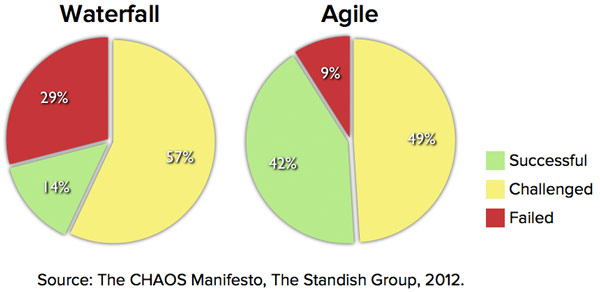Last updated: January 27, 2020
What is the Difference Between Waterfall vs. Agile?
According to the 2011 CHAOS Manifesto from the Standish Group, Agile projects are three times more successful than Waterfall projects.
The graph below shows the specific results reported from a study conducted based on projects executed from 2002 to 2012. They define a successful project as “on time, on budget, and with all planned features.“

While the use of Agile methodologies in organizations is increasing, many are still unclear on what differentiates Agile and Waterfall, and how to effectively utilize both processes.
This slideshow on the two methodologies starts off with the following thought-evoking quote: “Agile leaders lead teams, non-Agile ones manage tasks.” As this mindset continues to grow – particularly in the product development and IT sectors – Waterfall is gaining a reputation as the “old-fashioned” way of thinking and working.
The difference between Waterfall and Agile
Waterfall is…
– Structured
– One big project
– A sequential process
– Suited for situations where change is uncommon
– Internal
– A process that requires clearly defined requirements upfront.
Agile is…
– Flexible
– Many small projects
– Highly collaborative
– Best for those who want continuous improvements
– Involves customers
– A process in which requirements are expected to evolve and change. It is constantly in development and constantly changing.
The debate
Many Waterfall worshipers blatantly point out that if Agile is a better way of working, why do some Agile projects still fail?
In this blog post, Eric Ries, author of The Lean Startup, tells a story of witnessing a product manager struggle to get results from his hard-working team. The amount of dedication and work put in by all team members using the Waterfall process only led to frustration and failure. Waterfall projects restrict the modification of requirements, therefore making it more challenging to adapt your project as you along. In his post, he illustrates how repetitive some tasks are, and how much time you can lose by using this method. His goal is to see this team transition from the Waterfall process to an Agile one. This would allow his team to spend more time collaborating together, and work on projects more flexibly.
However, this article by Smart Data Collective states that “Agile is not right for every project team and is absolutely not a silver bullet that will solve your organization’s delivery problems. In fact, if you are already struggling, trying to change to a new methodology might make things worse.” This is a bump in the road that teams may encounter if they are adopting a new methodology. Doing so would mean that they would need a clear plan of how to make this transition happen without worsening their situation.
We want to know:
– Which methodology does your organization use?
– If you use Waterfall, are you thinking about transitioning to Agile?
Related blog posts:
Agile Project Management and The Social PM
Agile strategies and alternatives
Agile Technologies and Their Characteristics
Agile approach: Practicing it with OneDesk
Agile Adoption Statistics 2012
Scrum Methodology vs. Agile Methodology
SDLC Methodologies: Agile or Waterfall?
Why Agile Fails